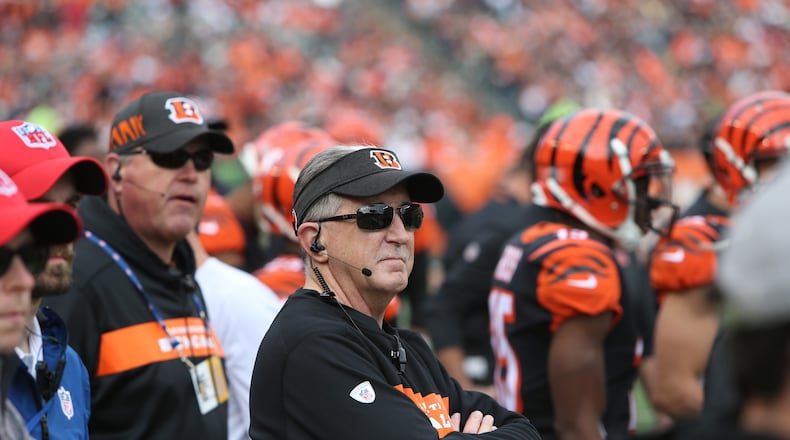How long his road to recovery might be is unknown, but Hamlin at least appears to be on it.
That might not be the case if not for the training staffs of each team and local medical professionals hired by the Bengals working together to quickly implement a plan Paul Sparling hoped never to see in action.
“I am pleased to see that every opportunity for this young man to to get a positive outcome is available to them because of the planning that took place, and way the plan was executed by everyone when it became apparent that it was necessary to do so,” said Sparling, a Stebbins grad who is athletic trainer emeritus for the Bengals.
Prior to stepping down last spring, Sparling was the head trainer for the Bengals for 30 years.
While Matt Summers replaced him in that role, Sparling has remained with the team to impart wisdom gained from his long tenure, to give the staff another set of eyes to help it go about its business more effectively and efficiently.
Yet what unfolded Monday night is not something Sparling had seen. Nor had anyone else.
Hamlin didn’t need anyone to check to see if his ankle was sprained or broken nor to test the stability of his knee or gauge his mental state after taking a hit to the head.
Hamlin’s heart had stopped, and the medical team reportedly needed an automated external defibrillator (AED) to restart it after administering CPR for several minutes.
“As I understand it, it’s never happened in the NFL based on what I’ve read,” Sparling said of the use of an AED. “But I can tell you, in all my years with the team, we’ve never used it except during ‘practice.’ And when I say during practice, I mean when we’re practicing potential scenarios. We’ve never had to actually use it.
“That being said, (the device) is on the plane. It’s on the buses. It’s on the practice field. It’s in the training room. It’s on the coaches level. It’s in the administrative offices. We have them everywhere.”
The proliferation of AEDs is one of the changes Sparling said has taken place in the NFL since he joined the organization in the 1980s. They were around then but not in such abundance.
The same could be said about the number of people at the ready when tragedy struck.
“We would have been ready in the ‘80s,” Sparling said. “Certainly the equipment is better. The training of everyone involved is better. The medical staffs are larger.
“Even when the team started in 1968, there was an ambulance crew at every game, but now you’ve got a significantly higher number of medical folks with emergency medicine training.”
That includes both team physicians and emergency room physicians from local hospitals who specialize in various practices, such as intubation.
“Now people have specific assignments with specific duties and you’ve got an abundance of redundancy if you will,” Sparling said.
Sparling said one of the Bengals’ team physicians specializes in emergency medicine, and he was directly involved in the response to Hamlin’s situation Monday night both in terms of providing care and helping coordinate the response on the sidelines.
“We brought him on probably five years ago,” Sparling said. “I think we might have been the first NFL team to do it. I recognized that situations can occur when you’re in a plane, at the hotel, as well as on the field, and I just thought it would be a good idea for us to to add that to our to our medical staff that’s with us. Ownership listened, and we did it and I think we’re better for it. I mean, he has proven invaluable.”
Sparling said every team in the NFL has an emergency action plan put together by the head trainer that accounts not only for responding to players but everyone in the stadium during games and practice.
On game day, members of each team’s medical staff meet an hour before the game to go over plans.
“That’s called the 60-minute meeting, and it involves all of the ancillary medical people, the home team’s medical staff, the visiting team’s medical staff, and even the officials and a representative of the league,” he said. “So we all review a checklist that we go through of how things are going to be run.
“And, again, this is the first time that we’ve had to actually implement the emergency action plan for this type of scenario that actually happened on the field.”
Members of the Bills training staff were first to respond to Hamlin on the field (per protocol), but they were quickly joined by members of the Bengals training staff and other medical personnel who worked together to revive him.
Sparling stressed teamwork was essential and noted the role trust between staffs from each team and the third-party medical professionals played in getting Hamlin stabilized.
“In general, when we see a player from an opposing team go down, we will routinely focus on what they’re doing and make sure they’re in our line of sight,” he said. “So if we recognize that this is bigger than a sprained ankle or a torn ACL, we’re ready to quickly make our way out to the to the field and figure out with them what they need.”
Sometimes, like Monday night, the situation becomes “all hands on deck.”
“The radio call is routinely put out and everybody jumps over ready,” he said. “They know what’s going on. They know what they’re supposed to do, and I was impressed.”
About the Author

